History
 Some nations really can’t be trusted with weapons of mass destruction. They are eager to start a war, and they don’t have the moral scruples necessary to care about the loss of life involved. When nuclear weapons began to be produced, nations like the Soviet Union, China, Germany, Iran, Iraq, and various others, simply couldn’t be trusted with these weapons, but it was difficult to stop them from developing them, just like it is today. Therefore, nations have had to develop ways to restrict the usage of these weapons.
Some nations really can’t be trusted with weapons of mass destruction. They are eager to start a war, and they don’t have the moral scruples necessary to care about the loss of life involved. When nuclear weapons began to be produced, nations like the Soviet Union, China, Germany, Iran, Iraq, and various others, simply couldn’t be trusted with these weapons, but it was difficult to stop them from developing them, just like it is today. Therefore, nations have had to develop ways to restrict the usage of these weapons.
On July 21, 1955, President Dwight D Eisenhower presented his “Open Skies” plan at the 1955 Geneva summit meeting with Prime Minister Anthony Eden of Great Britain, Premier Edgar Faure of France, and Premier Nikolai Bulganin of the Soviet Union…acting for Soviet leader Nikita Khrushchev, in Geneva in July 1955, to present the plan. The plan was never accepted, but it laid the foundation for President Ronald Reagan’s “Trust, But Verify” policy in relation to arms agreements with the Soviet Union. The planned agenda for the summit included discussions on the future of Germany and arms control, but as it became clear that no agreement could be  reached on the issue of possible German reunification or the precise configuration of an arms control agreement, considering what had happened in Germany after World War I, Eisenhower dramatically unveiled what came to be known as his “Open Skies” proposal. The proposal called for the United States and the Soviet Union to exchange maps indicating the exact location of every military installation in their respective nations. The purpose of the maps was to allow each nation to conduct aerial surveillance of the installations in order to assure that the other nations were in compliance with any arms control agreements that might be reached. While it sounded like a good idea, it had little chance of acceptance. The French and British expressed interest in the idea, but the Soviets rejected any plan that would leave their nation subject to surveillance by a Western power. Khrushchev declared that Eisenhower’s “Open Skies” was nothing more than an “espionage plot.”
reached on the issue of possible German reunification or the precise configuration of an arms control agreement, considering what had happened in Germany after World War I, Eisenhower dramatically unveiled what came to be known as his “Open Skies” proposal. The proposal called for the United States and the Soviet Union to exchange maps indicating the exact location of every military installation in their respective nations. The purpose of the maps was to allow each nation to conduct aerial surveillance of the installations in order to assure that the other nations were in compliance with any arms control agreements that might be reached. While it sounded like a good idea, it had little chance of acceptance. The French and British expressed interest in the idea, but the Soviets rejected any plan that would leave their nation subject to surveillance by a Western power. Khrushchev declared that Eisenhower’s “Open Skies” was nothing more than an “espionage plot.”
The truth is that “Open Skies” was definitely not an “espionage plot,” but then we all knew that. Eisenhower was later quoted as saying that he knew “the Soviets would never accept the plan, but thought that their rejection of the idea would make the Russians look like they were the major impediment to an arms control  agreement.” The problem the Soviets had was that US surveillance planes would quickly find out that the Soviet Union was far behind the United States in terms of its military capabilities. The United States soon found that out anyway, because just a few months after the Soviet rejection of “Open Skies,” the Eisenhower administration approved the use of high-altitude spy planes (the famous U-2s) for spying on the Soviet Union. Thirty years later, President Reagan would use much the same rhetoric in his arms control dealings with the Soviet Union. Arms control, he declared, could only be effective if compliance with such agreements could be verified. “Trust, but verify” became Reagan’s standard phrase, and the truth is they were both right. If these rogue nations can’t be held accountable, they will continue to develop weapons of mass destruction, even while they are in a supposed agreement not to.
agreement.” The problem the Soviets had was that US surveillance planes would quickly find out that the Soviet Union was far behind the United States in terms of its military capabilities. The United States soon found that out anyway, because just a few months after the Soviet rejection of “Open Skies,” the Eisenhower administration approved the use of high-altitude spy planes (the famous U-2s) for spying on the Soviet Union. Thirty years later, President Reagan would use much the same rhetoric in his arms control dealings with the Soviet Union. Arms control, he declared, could only be effective if compliance with such agreements could be verified. “Trust, but verify” became Reagan’s standard phrase, and the truth is they were both right. If these rogue nations can’t be held accountable, they will continue to develop weapons of mass destruction, even while they are in a supposed agreement not to.
 Most of us have heard of shrapnel. Shrapnel shells have been obsolete since the end of World War I for anti-personnel use, but they were “anti-personnel artillery munitions which carried many individual bullets close to a target area and then ejected them to allow them to continue along the shell’s trajectory and strike targets individually. They relied almost entirely on the shell’s velocity for their lethality.” These days, high-explosive shells are used for that role. The functioning and principles behind Shrapnel shells are fundamentally different from high-explosive shell fragmentation. Shrapnel is named for its inventor, Lieutenant-General Henry Shrapnel (1761–1842). Shrapnel was a British artillery officer, whose experiments, initially conducted on his own time and at his own expense, culminated in the design and development of a new type of artillery shell.
Most of us have heard of shrapnel. Shrapnel shells have been obsolete since the end of World War I for anti-personnel use, but they were “anti-personnel artillery munitions which carried many individual bullets close to a target area and then ejected them to allow them to continue along the shell’s trajectory and strike targets individually. They relied almost entirely on the shell’s velocity for their lethality.” These days, high-explosive shells are used for that role. The functioning and principles behind Shrapnel shells are fundamentally different from high-explosive shell fragmentation. Shrapnel is named for its inventor, Lieutenant-General Henry Shrapnel (1761–1842). Shrapnel was a British artillery officer, whose experiments, initially conducted on his own time and at his own expense, culminated in the design and development of a new type of artillery shell.
Henry Shrapnel was born June 3, 1761 at Midway Manor in Bradford-on-Avon, Wiltshire, England, the ninth child of Zachariah Shrapnel and his wife, Lydia. Shrapnel became an artillery officer and inventor of a form of artillery case shot (shrapnel). He was commissioned in the  Royal Artillery in 1779, and served in Newfoundland, Gibraltar, and the West Indies. He was wounded in Flanders in the Duke of York’s unsuccessful campaign against the French in 1793. In 1804 he became an inspector of artillery and spent several years at Woolwich arsenal.
Royal Artillery in 1779, and served in Newfoundland, Gibraltar, and the West Indies. He was wounded in Flanders in the Duke of York’s unsuccessful campaign against the French in 1793. In 1804 he became an inspector of artillery and spent several years at Woolwich arsenal.
In 1784, while a lieutenant in the Royal Artillery, he perfected, with his own resources, an invention of what he called “spherical case” ammunition: a hollow cannonball filled with lead shot that burst in mid-air. He successfully demonstrated this in 1787 at Gibraltar. He intended the device as an anti-personnel weapon. In 1803, the British Army adopted a similar, but elongated explosive shell which immediately acquired the inventor’s name. It has lent the term “shrapnel” to fragmentation from artillery shells and fragmentation in general ever since, long after it was replaced by high explosive rounds, but this usage is not the original 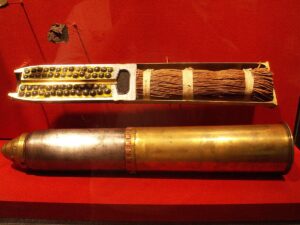 meaning of the word. Until the end of World War I, the shells were still manufactured according to his original principles.
meaning of the word. Until the end of World War I, the shells were still manufactured according to his original principles.
In 1814, the British Government recognized Shrapnel’s contribution by awarding him £1200 (UK£ 85,000 in 2021) a year for life, however, bureaucracy kept him from receiving the full benefit of this award. He was promoted to the office of Colonel-Commandant, Royal Artillery, on March 6, 1827, and to the rank of lieutenant-general on January 10, 1837. Shrapnel lived at Peartree House, near Peartree Green, Southampton from about 1835 until his death on March 13, 1842 at Southampton, Hampshire.
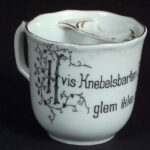 Through the years, there have been items used that we would not use today, and in fact, we might actually laugh at them. One such item is the “mustache cup.” The mustache cup made it’s debut in the Victorian era. During that time, the men with mustaches didn’t want their mustache being dipped into their tea, so the cups were made with a bow-shaped guard to keep the mustache out of the tea.
Through the years, there have been items used that we would not use today, and in fact, we might actually laugh at them. One such item is the “mustache cup.” The mustache cup made it’s debut in the Victorian era. During that time, the men with mustaches didn’t want their mustache being dipped into their tea, so the cups were made with a bow-shaped guard to keep the mustache out of the tea.
For those of us without a mustache and those of this era, the possibility of dipping the mustache into the tea was given little, if any thought…even for those with mustaches. “The moustache cup (or mustache cup) is a drinking cup with a semicircular ledge inside. The ledge has a half moon-shaped opening to allow the passage of liquids and serves as a guard to keep moustaches dry. It is generally acknowledged to have been invented in the 1860s by British potter Harvey Adams (born 1835).” The new invention spread all over the European continent and soon, every famous potter was making the new cups. A multiplicity of mustache cups were made by famous manufactories such as Meissen, Royal Crown Derby, Imari, Royal Bayreuth, Limoges, and others. Each potter created his own version of this masculine tableware and the news of that invention soon spread to America.
The Victorian era was a time when the mustaches flourished. In fact, from 1860 to 1916, the British military actually required all of its soldiers to sport a mustache for the authority it imparted to the man with the mustache. Special care was given to the mustache, including mustache wax, which was applied to the moustache to keep it stiff, with every hair in place. When drinking hot liquids, steam from the drink would melt the wax, which would drip into the cup. Sipping hot tea or coffee would also often stain mustaches. Knowing that makes the usage of the mustache cup a little more sensible, and not just some weird passing fad.
Many mustache cups were made in America over the years, with the earliest marked with names which led buyers to believe they were actually manufactured in England. English-made ceramics were very popular…not  so much American-made ceramics. So, with the exception of the quadruple silver plate mustache cups made in the United States, it is extremely difficult to find an authentic Victorian mustache cup bearing an American pottery mark these days.
so much American-made ceramics. So, with the exception of the quadruple silver plate mustache cups made in the United States, it is extremely difficult to find an authentic Victorian mustache cup bearing an American pottery mark these days.
The mustache cup began to go out of style between 1920 and 1930, and so mustache cup production trickled to a halt. Today, with the collectors of all things antique, these examples of Victorian male elegance are coveted by a growing number of enthusiasts. There are also still those who use mustache wax, and it would seem that the mustache cup is still an item of necessity for these men.
 As many of us know, from history, there was a time in United States history when alcohol was illegal. Some will debate if it should still be today, but it is not. Prohibition, as it was called, ran from 1920 to 1933. Prohibition in the United States was a nationwide constitutional ban on the production, importation, transportation, and sale of alcoholic beverages. The Prohibitionists were led by pietistic Protestants. The idea was to heal what they saw as an ill society beset by alcohol-related problems such as alcoholism, family violence and saloon-based political corruption. There are many alcohol related issues that really do fall into these categories, but you can’t make people stop something that they are intent on doing. Drugs are the same, but we have to draw the line somewhere, or we will have a “zombieistic” society.
As many of us know, from history, there was a time in United States history when alcohol was illegal. Some will debate if it should still be today, but it is not. Prohibition, as it was called, ran from 1920 to 1933. Prohibition in the United States was a nationwide constitutional ban on the production, importation, transportation, and sale of alcoholic beverages. The Prohibitionists were led by pietistic Protestants. The idea was to heal what they saw as an ill society beset by alcohol-related problems such as alcoholism, family violence and saloon-based political corruption. There are many alcohol related issues that really do fall into these categories, but you can’t make people stop something that they are intent on doing. Drugs are the same, but we have to draw the line somewhere, or we will have a “zombieistic” society.
As Prohibition progressed, many communities introduced alcohol bans and enforcement of these new prohibition laws became a topic of debate. Prohibition supporters were called “Drys.” The “Drys” presented prohibition as a battle for public morals and health. The progressives, along with the Democratic and Republican parties picked up on the movement, and it gained a national grassroots base through the Woman’s Christian Temperance Union. After 1900, it was coordinated by the Anti-Saloon League. There were those who opposed Prohibition, including the beer industry, who mobilized “Wet” supporters from the wealthy Catholic and German Lutheran communities, but the influence of these groups receded from 1917 following the entry of the United States into the First World War against Germany.
By a succession of state legislatures, the alcohol industry was curtailed, and finally ended nationwide under the Eighteenth Amendment to the United States Constitution in 1920. The Eighteenth Amendment passed “with a 68 percent supermajority in the House of Representatives and 76 percent support in the Senate,” as well as ratification by 46 out of the 48 states we had at the time. That enabled legislation, known as the Volstead Act, which set down the rules for enforcing the federal ban and defined the types of alcoholic beverages that were prohibited. Unlike most people think, not all alcohol was banned. For example, religious use of wine was permitted. Private ownership and consumption of alcohol were not made illegal under federal law, but local laws were stricter in many areas, with some states banning possession outright.
With prohibition came the criminal element associated with a refusal to comply. Criminal gangs gained control of the beer and liquor supply in many cities. By the late 1920s, a new opposition to Prohibition emerged nationwide. Critics attacked the policy saying it was actually causing more crime, lowering local revenues, and imposing “rural” Protestant religious values on “urban” America. In another bizarre twist of Prohibition in the United States, the United States government literally decided that if people would not comply with the new law, they would make the penalty much stiffer. When the people continued to consume alcohol despite its being banned, law officials got frustrated and decided to try a different kind of deterrent…death. They literally ordered the poisoning of industrial alcohols manufactured in the United States. These were products regularly stolen by bootleggers to use is making moonshine. By the end of Prohibition in 1933, the federal poisoning program is estimated to have killed at least 10,000 people.
Prohibition ended with the ratification of the Twenty-first Amendment, which repealed the Eighteenth  Amendment on December 5, 1933, though prohibition continued in some states. To date, this is the only time in American history in which a constitutional amendment was passed for the purpose of repealing another. Looking back on Prohibition, you will find researchers who say that alcohol consumption declined substantially due to Prohibition. They will also say that rates of liver cirrhosis, alcoholic psychosis, and infant mortality declined as well. Prohibition’s effect on rates of crime and violence is rather another story, because of the criminal element that made and sold alcohol in spite of the law. Nevertheless, Prohibition lost supporters every year it was in action, and lowered government tax revenues at a critical time before and during the Great Depression. I guys it all comes down to money in the end.
Amendment on December 5, 1933, though prohibition continued in some states. To date, this is the only time in American history in which a constitutional amendment was passed for the purpose of repealing another. Looking back on Prohibition, you will find researchers who say that alcohol consumption declined substantially due to Prohibition. They will also say that rates of liver cirrhosis, alcoholic psychosis, and infant mortality declined as well. Prohibition’s effect on rates of crime and violence is rather another story, because of the criminal element that made and sold alcohol in spite of the law. Nevertheless, Prohibition lost supporters every year it was in action, and lowered government tax revenues at a critical time before and during the Great Depression. I guys it all comes down to money in the end.
 When you have a landmark city…a City of Lights, you want to protect it from the ravages of war. Paris was just that…the City of Lights, and during World War I, in an effort to protect the city from enemy bombs, the French built a “fake Paris” to the city’s immediate north. Complete with a duplicate Champs-Elysées and Gard Du Nord, this “dummy version” of Paris was built by the French towards the end of the war as a means of throwing off German bomber and fighter pilots flying over French skies. Wily military strategists, understandably tired of the enemy dropping bombs on their beautiful hometown, had decided that the best way to keep the city safe was to bring in a stunt double…a life-sized mock up situated to act as a decoy to draw fire from Paris proper.
When you have a landmark city…a City of Lights, you want to protect it from the ravages of war. Paris was just that…the City of Lights, and during World War I, in an effort to protect the city from enemy bombs, the French built a “fake Paris” to the city’s immediate north. Complete with a duplicate Champs-Elysées and Gard Du Nord, this “dummy version” of Paris was built by the French towards the end of the war as a means of throwing off German bomber and fighter pilots flying over French skies. Wily military strategists, understandably tired of the enemy dropping bombs on their beautiful hometown, had decided that the best way to keep the city safe was to bring in a stunt double…a life-sized mock up situated to act as a decoy to draw fire from Paris proper.
London’s Daily Telegraph explains that the fake city wasn’t just “a bunch of cardboard cutouts.” No, far from it, in fact. There were “electric lights, replica buildings, and even a copy of the Gare du Nord—the station from which high-speed trains now travel to and from London.” The painters went so far as to use paint to create “the impression of dirty glass roofs of factories.” Fake trains and railroad tracks were lit up as well. There was a phony Champs-Elysées. Many of us today would say, “How could that work? The Germans must have known where they were dropping their bombs!” Nevertheless, it stands to reason that in the early 20th century, the plan could have worked. “Radar was in its infancy in 1918, and the long-range Gotha heavy bombers being used by the German Imperial Air Force were similarly primitive,” the Telegraph notes. “Their crew would hold bombs by the fins and then drop them on any target they could see during quick sorties over major cities like Paris and London.”
No one really knows how well the plan might have worked, because it was never put to the test. World War I ended before the fake city was finished. Both the real Paris and the fake one escaped significant damage. The fake version has long since been dismantled, though photos of it still remain. I suppose it was a ghost town of  it’s own, and had it remained, it would have been interesting to visit and very likely a tourist attraction. Seriously…the idea of a to-scale decoy city made of wood and canvas dumped out in the leafy suburbs just a few miles from Paris’ instantly recognizable landscape may seem a little far fetched, if not completely crazy. Nevertheless, as the war progressed and French anti-aircraft technology improved, the daylight airship bombings which had previously caused such havoc were eventually rendered too risky for the planes. As such, any bombing raids were forced to take place under cover of darkness and it was at this point that an illuminated sham Paris began to…shall we say…shine!!
it’s own, and had it remained, it would have been interesting to visit and very likely a tourist attraction. Seriously…the idea of a to-scale decoy city made of wood and canvas dumped out in the leafy suburbs just a few miles from Paris’ instantly recognizable landscape may seem a little far fetched, if not completely crazy. Nevertheless, as the war progressed and French anti-aircraft technology improved, the daylight airship bombings which had previously caused such havoc were eventually rendered too risky for the planes. As such, any bombing raids were forced to take place under cover of darkness and it was at this point that an illuminated sham Paris began to…shall we say…shine!!
To further validate the idea, French fighter pilots reported that during night flights they looked for familiar features of the landscape below when attempting to locate Paris. According to their research, railways, lakes, rivers, roads and woodland were the most useful indicators that they were in the neighborhood. Using this information, the mastermind behind the replica project, Fernand Jacopozzi, along with his team of highly capable engineers worked to make life even harder for the German pilots who were already struggling to find their bearings in an era before radar or precision targeting. Intending to confuse an enemy pilot sufficiently that he would start to doubt his own bearings, the construction of Paris’ mirror image began in earnest at Villepinte to the northeast where a working model of the Gare de l’Est gradually began to take form.
The “fake Paris” was exquisite. No detail was overlooked: “complex, sprawling networks of lights arranged skillfully creating the impression of railway tracks and avenues, as well as storm lamps clustered together on ingenious moving platforms designed to simulate vast steam trains in motion. Immense empty sheds masquerading as factories had translucent sheets of painted canvas stretched tightly across their wooden frames which were illuminated from underneath, an arrangement that to anyone passing overhead would look remarkably like the dirty glass roofs characteristic of industrial buildings. Working furnaces were also installed to add an extra dimension of reality and the factory’s lights were even configured to dim noticeably during an air raid, fooling enemy pilots into believing that the facsimile buildings were, in fact, occupied.”
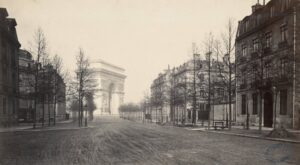
Because World War I ended, it was only this small part of Zone A that was built. The German bombing campaign came to an end in September 1918 and the armistice was signed at Compiègne two months later. The mock factories and railway network at Villepinte were dismantled shortly after the hostilities ceased. By the beginning of the 1920s little remained of the project. Though his fascinating idea never really got much further than the drawing board, the designs of Fernand Jacopozzi inspired similarly ambitious plans in the United States during World War II.

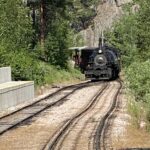 While riding the 1880 Train on the last day of our annual trip to the Black Hills, Bob and I were sitting back, relaxing and enjoying the ride. It is a favorite part of our trip each year. One of the things that I like to do on these train rides, is to listen to what the people around us think of the journey. When you ride the train every year. You know the area, and while it is still very interesting to me, I do know the area. Others don’t, so it’s interesting to see what they think of this area I love so much. I almost feel like a local listening to the tourists who are viewing this place for the first time.
While riding the 1880 Train on the last day of our annual trip to the Black Hills, Bob and I were sitting back, relaxing and enjoying the ride. It is a favorite part of our trip each year. One of the things that I like to do on these train rides, is to listen to what the people around us think of the journey. When you ride the train every year. You know the area, and while it is still very interesting to me, I do know the area. Others don’t, so it’s interesting to see what they think of this area I love so much. I almost feel like a local listening to the tourists who are viewing this place for the first time.
This trip’s most profound conversation was a little different, and it really made me think. The train has a recorded narrative, and a little boy, about 5 or 6 years old was listening to it. So often, children don’t really listen to such things, but this little boy was rather intently listening to the message. So as he listened, the narrator said that 
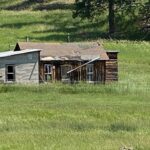 the train was in use during World War I and World War II, and the boy said, “What’s a war?” That really made me wonder…how nice it would be, not to know what war is. Yes, there have been wars in his lifetime, and indeed, we are in one even now, but this little boy is too young to really fathom the meaning of the word…war. He still possessed an innocence when it comes to war, killing, and death. That innocence is about to end, I suppose, because once his aunt or mother answered his question, he will forever know what a war is. He cannot go back to that innocence again. It is gone.
the train was in use during World War I and World War II, and the boy said, “What’s a war?” That really made me wonder…how nice it would be, not to know what war is. Yes, there have been wars in his lifetime, and indeed, we are in one even now, but this little boy is too young to really fathom the meaning of the word…war. He still possessed an innocence when it comes to war, killing, and death. That innocence is about to end, I suppose, because once his aunt or mother answered his question, he will forever know what a war is. He cannot go back to that innocence again. It is gone.
I came away from that experience a little sad. Children have such an innocent joy, and for this boy, that is changing. True…he won’t fully lose that innocence in one explanation, and it will depend on how much the 
 adults with him can soften the truth for him, but no matter what we do or say, war and death go together, and death by war is not pretty. This boy has an imagination, and if he continues to question the adults in his life, he will begin to get a clear picture of war, and what it really is. Then, as he grows, that picture will become more and more vivid. He will know what death by war means. War is a part of life, and eventually we all know what war means, but for me, the question felt sad, because I was witnessing the beginning of the end of his innocence. It’s a moment I wont easily forget either.
adults with him can soften the truth for him, but no matter what we do or say, war and death go together, and death by war is not pretty. This boy has an imagination, and if he continues to question the adults in his life, he will begin to get a clear picture of war, and what it really is. Then, as he grows, that picture will become more and more vivid. He will know what death by war means. War is a part of life, and eventually we all know what war means, but for me, the question felt sad, because I was witnessing the beginning of the end of his innocence. It’s a moment I wont easily forget either.
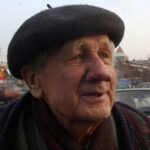
 Using prisoners-of-war as free labor in the concentration camps was not an unheard of practice during World War II. Many of the prisoners in Auschwitz were forced to do administrative and labor duties, such as sorting new arrivals’ possessions, constructing and expanding the camps, and taking photos of the other captives. In the photo lab at Auschwitz alone, nearly 39,000 prison photographs were taken. The problem with those photos was that when the Nazis began to realize that they were going to lose the war, they knew that all those photos were proof positive of their guilt in the matter of the Holocaust. That meant that the photos had to be destroyed.
Using prisoners-of-war as free labor in the concentration camps was not an unheard of practice during World War II. Many of the prisoners in Auschwitz were forced to do administrative and labor duties, such as sorting new arrivals’ possessions, constructing and expanding the camps, and taking photos of the other captives. In the photo lab at Auschwitz alone, nearly 39,000 prison photographs were taken. The problem with those photos was that when the Nazis began to realize that they were going to lose the war, they knew that all those photos were proof positive of their guilt in the matter of the Holocaust. That meant that the photos had to be destroyed.
During the evacuation of Auschwitz in 1945, photo lab workers Wilhelm Brasse and Bronislaw Jureczek were ordered to burn all photographic evidence. The men knew that to do so would mean that the Nazis would get away with the heinous murders they had committed. So, they came up with a way to save the pictures. They placed wet photo paper at the bottom of the furnace before placing the real pictures inside. With the furnace so packed and the wet paper creating so much smoke, the blaze went out quickly. Then, once they were unsupervised, the men were able to take the unharmed pictures from the furnace to smuggle them out. The precious pictures of victims of the Holocaust were then cataloged, and have been kept in the Archives of the Auschwitz-Birkenau State Museum.
On July 11, 1944, evidence of mass murder of Jews at the extermination camp was provided to Winston Churchill by four escapees from Auschwitz. For two years, the Nazis had managed to keep the gas chambers in Auschwitz, southern Poland, a secret. Churchill wrote to his Foreign Secretary Anthony Eden, “There is no doubt this is probably the greatest and most horrible crime ever committed in the whole history of the world…all concerned in this crime who may fall into our hands, including people who only obeyed orders by carrying out the butcheries, should be put to death.”
Auschwitz was the principal Nazi extermination camp in World War II. The complex covered at least 15 square miles. As World War II was coming to a close, and the Nazis were fleeing their own demise, the camp was evacuated, there were about 67,000 inmates who were still alive there. About 56,000 of these are led away. The rest were too sick to move, so they were left behind to die. As many as 250,000 people will die on the roads before the end of the war. Originally, the site for Auschwitz was chosen because the main railway lines from Germany and Poland passed through the area. By taking the prisoners to Poland, the Nazis hoped to keep their existence a secret. When the prisoners were sent to Auschwitz, they actually had to pay their own way…to be stuffed into a cattle car, so tightly that they couldn’t even fall down if they passed out or died. Prisoners deported to Auschwitz went there to die. The Nazis had no plans for them to survive. Auschwitz contained five crematoria, made and patented by German engineering company Töpf and Sons. It was estimated that they could dispose of 4,756 corpses a day. The crimes against humanity that had been committed here were atrocious, and panic had set in among the SS guards, who feared for their lives at the hands of the ruthless Red Army when it arrived.
For the prisoners, the end was also in sight, either by death, or by liberation for the few survivors of one of humanity’s most vile atrocities. The snow across the grounds of Auschwitz was deep, and temperatures are well below freezing. The Soviet Red Army was only a few miles away. Many SS officers and their families had already left, with cases full of valuables stolen from murdered inmates. Those on the death marches from Auschwitz survived by eating the snow on the shoulders of the people in front of them, because if they bent down to pick up the slush they risked being shot. As the prisoners marched slowly west through Poland, SS Lieutenant Colonel Rudolf Höss was heading in the opposite direction. Höss had been given the task of building Auschwitz by Himmler and had been the camp’s brutal commandant, living in luxury with his wife and five children just 100 yards from the camp grounds. After consideration, he headed back to Auschwitz, past what he described as “stumbling columns of corpses,” to make sure all evidence linking him to the genocide had been destroyed. But Höss was forced to turn his car around as the Russians advanced toward him. In 1946, he was captured and a year later hanged at Auschwitz.
Inmates, Brasse and Jureczek employed at Auschwitz’s Identification Service saved the thousands of negatives 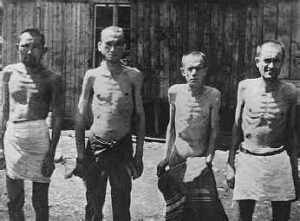
 of prisoners’ ID photographs, at great personal risk to themselves, and because they did, at least some of the guilty ones could be held accountable. The photos were intended to be a way to identify prisoners if they escaped, but their rapid starvation made these images useless. Nevertheless, Brasse and Jureczek were keen on preserving evidence of the atrocities at Auschwitz, and in the end, their efforts paid off.
of prisoners’ ID photographs, at great personal risk to themselves, and because they did, at least some of the guilty ones could be held accountable. The photos were intended to be a way to identify prisoners if they escaped, but their rapid starvation made these images useless. Nevertheless, Brasse and Jureczek were keen on preserving evidence of the atrocities at Auschwitz, and in the end, their efforts paid off.
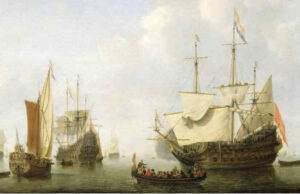
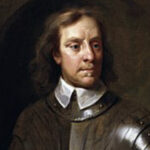 Not many wars can be called…peaceful, but the Dutch-Scilly War is one that definitely can. Some wars start over borders, some over principles, and some over…well, who remembers. The Dutch-Scilly War lasted 335 years. That’s an amazingly long time in any war, and even more so when you consider that it had no battles or deaths. Oliver Cromwell had fought the Royalists to the edges of the Kingdom of England. Cromwell was an English general and statesman who, first as a subordinate and later as Commander-in-Chief, led armies of the Parliament of England against King Charles I during the English Civil War, subsequently ruling the British Isles as Lord Protector from 1653 until his death in 1658.
Not many wars can be called…peaceful, but the Dutch-Scilly War is one that definitely can. Some wars start over borders, some over principles, and some over…well, who remembers. The Dutch-Scilly War lasted 335 years. That’s an amazingly long time in any war, and even more so when you consider that it had no battles or deaths. Oliver Cromwell had fought the Royalists to the edges of the Kingdom of England. Cromwell was an English general and statesman who, first as a subordinate and later as Commander-in-Chief, led armies of the Parliament of England against King Charles I during the English Civil War, subsequently ruling the British Isles as Lord Protector from 1653 until his death in 1658.
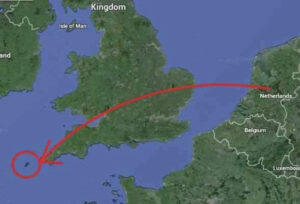
In the West of Britain, Cornwall was the last Royalist stronghold. In 1648, Cromwell pushed on until mainland Cornwall was in the hands of the Parliamentarians. The Royalist Navy was forced to retreat to the Isles of Scilly, which lay off the Cornish coast and were under the ownership of Royalist John Granville. Before fleeing Cornwall, the Royalists raided a few Dutch shipping vessels as an act of revenge, then escaped to the Isles of Scilly. With that, the war was on. The Dutch turned up in Scilly demanding reparations from the Royalists. The Royalists refused and the Dutch declared war. The whole point of the war was to get restitution for the damage done by the Royalists, but the Dutch quickly realized that the Royalists were “dead broke!!” They didn’t have a penny to their name. Well, as we all know, you can’t get blood from a turnip, so going to war to receive money that could never be paid would do no good. In the end, they decided to call it a day and go home. A smart move if you ask me. The problem with the whole 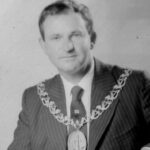
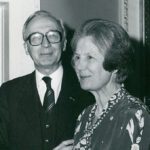 thing is that they never declared peace with the Isles. They just completely forgot they were at war.
thing is that they never declared peace with the Isles. They just completely forgot they were at war.
In 1986, Roy Duncan, historian and Chairman of the Isles of Scilly Council, decided to investigate. He wrote to the Dutch Embassy in London. Research proved that that no peace treaty had ever been signed, so Duncan invited the Dutch ambassador Jonkheer Rein Huydecoper to visit the islands and officially end the “conflict” at last. Peace was declared on April 17, 1986, exactly 335 years after the supposed declaration of war. The Dutch ambassador joked that it must have been horrifying to the Scillonians “to know we could have attacked at any moment.”
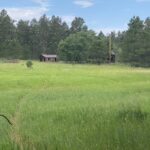
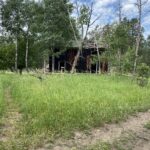 A couple of days ago, my husband, Bob Schulenberg and I went for a hike through a South Dakota ghost town called Spokane. It was founded in 1890 to extract precious gold, the mine proved richer in silver, copper, zinc, mica and graphite. The town hit its stride in 1927 with its biggest year ever totaling $144,742 in profits which helped fund the school building whose bones can still be seen, at least for now. The tow is rapidly deteriorating, so they won’t be around much longer. By 1940, the mine and town were all but abandoned. The town limped along, with the manager’s house being the last one to be abandoned in the 1970s. The Spokane Mine was discovered in 1889 by Sylvester Judd more or less by accident. As the story goes, “he had placed a rock (likely galena or cerussite) from the outcrop on his wooden stove. He was amazed when he found molten lead coming from the mineral.” The town was formed the same year the mine began operations, in 1890, but it was not the town or it’s dilapidated buildings, but rather the tragic history of the place that caught my attention.
A couple of days ago, my husband, Bob Schulenberg and I went for a hike through a South Dakota ghost town called Spokane. It was founded in 1890 to extract precious gold, the mine proved richer in silver, copper, zinc, mica and graphite. The town hit its stride in 1927 with its biggest year ever totaling $144,742 in profits which helped fund the school building whose bones can still be seen, at least for now. The tow is rapidly deteriorating, so they won’t be around much longer. By 1940, the mine and town were all but abandoned. The town limped along, with the manager’s house being the last one to be abandoned in the 1970s. The Spokane Mine was discovered in 1889 by Sylvester Judd more or less by accident. As the story goes, “he had placed a rock (likely galena or cerussite) from the outcrop on his wooden stove. He was amazed when he found molten lead coming from the mineral.” The town was formed the same year the mine began operations, in 1890, but it was not the town or it’s dilapidated buildings, but rather the tragic history of the place that caught my attention.
A man named James Shepard, or Jim as he was know to family and friends in Spokane, heard about the gold rush in the Black Hills and decided to take his family from North Carolina, to the town of Spokane to stake his claim. A local man named Frank Cox had not kept up assessment work on the Spokane Mine, which he himself had “jumped” when it had been neglected by someone else. It isn’t the best way to stake a claim, but it is legal apparently. Jim had enough to stake his claim to the mine, so he claimed it and on June 21, 1908, when he drove his stake at the site. Jim was well liked and since he did things right, people respected him and his family.
Frank Cox’s wife, the Sunday school teacher, observed the staking of the claim by Shepard while riding to the schoolhouse and informed her husband. Then the real trouble began. That evening, Jim rode his horse to bring his free-roaming milk cow back to the house. According to his account, when he had his guard down, Frank and his son Henry stepped out from behind some trees. Frank yelled, “You son-of-a-bitch, you have driven your last stake!” and shot Jim with a shotgun. He was able to ride home, where his wife, Jessie, frantically helped him into bed and rode for help.
Jessie went to the Hoffman home and told them that Jim had been shot. Edgar H. Hoffman, who was 12 years old, never forgot that night. “Mrs. Shepard was a tall, dark mountain woman. Her clothes and the saddle were soaked and spotted with blood,” he said. A neighbor rode to the nearest doctor, but that was 17 miles away in Custer. It was an awful stormy night with heavy rain and lightning flashes. Not an easy way to make such an important trip. The next morning, the doctor and sheriff arrived to just in time to hear hear Jim’s dying words…words that incriminated Frank and Henry. The town was horribly shaken by the murder. The crowd could only be described as “angry and hostile” at Jim’s funeral.
“In order to prevent violence, the minister had the congregation point the finger of guilt at whoever they felt had committed the murder. Everyone pointed the finger at the Cox house. From then on, the Coxes were ostracized by the Spokane community and they sent their son away to relatives,” wrote Inez Shepard Shafer, Jim Shepard’s only surviving child.
In the July 10, 1909 edition of the Keystone Record, it was stated that the trial was “one of the longest and hardest fought preliminary hearings ever held in Custer County. It was thought at first by friends of Cox that he would have no trouble in proving an alibi, as he was at the Ideal [mine] all day Sunday and slept there that night. This is true, but there was about an hour and a half in the evening he was unable to account for, and about the time the shooting was supposed to have taken place. It is unfortunate for all concerned, and if Cox proves his innocence, and many believe he will, the chances are we will never know who killed James Shepard.”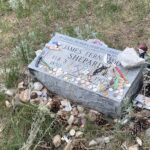
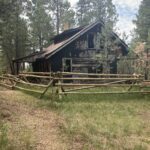
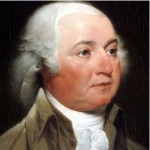
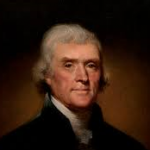 Historians, who have studied the lives of Presidents John Adams and Thomas Jefferson, agree that while the two men were friends, they also had a long history as “frenemies.” It is fairly common with politicians, because each one has definite ideas about how things should be run. So, the two rivals always had a volatile relationship.
Historians, who have studied the lives of Presidents John Adams and Thomas Jefferson, agree that while the two men were friends, they also had a long history as “frenemies.” It is fairly common with politicians, because each one has definite ideas about how things should be run. So, the two rivals always had a volatile relationship.
Their friendship began in the early days of the nation, despite their vastly different political views. Adams was a strong believer in a strong central government, and Jefferson championed states’ rights. I would imagine that there was a measure of frustration for Adams, as he watched his administration being dismantled in the early years of the Jefferson administration. Nevertheless, as a Conservative, I have to agree with the Thomas Jefferson way of government.
Adams preceded Jefferson as president friend 1797 to 1800. During the Adams presidency, it became very apparent that the two men were very different, and their political views were just as different. The hot-tempered Adams was a firm believer in a strong centralized government, while the genteel Jefferson believed federal government should take a more hands-off approach and defer to individual states’ rights. They clashed loudly and often. As Adams’ vice president, Jefferson was horrified by what he considered to be Adams’ abuse  of the presidential power…particularly his passage of the restrictive Alien and Sedition Acts of 1798. Jefferson abandoned Adams and Washington for his estate at Monticello. There, he plotted how to bring his Republican faction back into power in the presidential election of 1800. After an exceptionally bitter campaign, in which both parties engaged in slanderous attacks on each other in print, Jefferson emerged victorious. It appeared the former friends would be eternal enemies. The former revolutionaries went on to resume their friendship over 14 years of correspondence during their golden years.
of the presidential power…particularly his passage of the restrictive Alien and Sedition Acts of 1798. Jefferson abandoned Adams and Washington for his estate at Monticello. There, he plotted how to bring his Republican faction back into power in the presidential election of 1800. After an exceptionally bitter campaign, in which both parties engaged in slanderous attacks on each other in print, Jefferson emerged victorious. It appeared the former friends would be eternal enemies. The former revolutionaries went on to resume their friendship over 14 years of correspondence during their golden years.
On July 4, 1826, the 50th anniversary of the adoption of The Declaration of Independence, these “frenemies” died on the same day and within five hours of each other. Jefferson and Adams were the last surviving members of the original American revolutionaries who had stood up to the British empire and forged a new political system in the former colonies. When Adams died at the age of 90, his last words, as the country celebrated Independence Day were, “Thomas Jefferson still survives.” Adams was wrong. Jefferson had died five hours earlier at Monticello at the age of 83.

